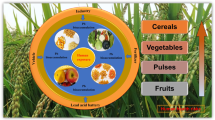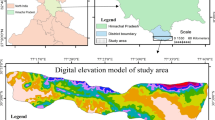Abstract
From a previous pilot study, the Tapajós River basin riparian population was found to have elevated blood lead (PbB) levels, ranging from 0.59 to 48.3 μg/dL. Preliminary analyses of these results initially pointed to the metallic plates used in the production of manioc flour as a possible source. The main objective of this study was to investigate the potential environmental sources of Pb in the manioc flour in this region. The study was carried out in eight communities on the Tapajós River, where samples of manioc flour, metal plates and soil from manioc plantations were collected. In addition, samples of deposited sediments from the Tapajós River and its tributaries and riverbank sediments were collected. The metal composition was analyzed by SEM, XRF and GFAAS. The results show that the concentrations of Pb in manioc flour ranges from 0.08 to 0.31 mg/kg and the manioc paste from 0.004 to 0.037 mg/kg. The metallic plates used in the manioc-roasting process are made of carbon steel without Pb in the bulk alloy. Pb concentrations in soils where manioc roots were cultivated range from 8.9 to 26.1 mg/kg and Zn concentrations range from 12.7 to 59.1 mg/kg, indicating a contribution of polymetallic geological deposits. The clay-rich samples have high metal contents (including Pb, Zn and Cu). The Pb content of the clay samples ranges from 10.6 to 25.1 mg/kg. These results suggest that it is unlikely that the Pb found in the manioc flour originates from the metal plates used in its roasting process, rather, it seems to be associated to environmental factors determined by the local geology and soil composition.





Similar content being viewed by others
References
Aguja MA, Juliani C, Tokashiki CC, Echeverri-Misas CM, Monteiro LVS, Lagler B (2014) Rochas hospedeiras das mineralizações epitermais e tipo pórfiro na Província Mineral do Tapajós. Anais 47° Congresso Brasileiro de Geologia, Salvador (in Portuguese)
Alloway BJ (1995) Heavy metals in soils. Chapman and Hall, Glasgow
Anticona C, Bergdahl IA, Lundh T, Alegre Y, Sebastian MS (2011) Lead exposure in indigenous communities of the Amazon basin. Peru Int J Hyg Environ Health 215:59–63
Barbosa F Jr, Fillion M, Lemire M, Passos CJ, Rodrigues JL, Philibert A, Guimarães JR, Mergler D (2009) Elevated blood lead levels in a riverside population in the Brazilian Amazon. Environ Res 109(5):594–599
BRASIL (2005) Ministério do Meio Ambiente. Resolução CONAMA n 357. Ciência e Natura, Santa Maria (in Portuguese)
BRASIL (2009) Ministério do Meio Ambiente Resolução CONAMA n420. Ciência e Natura, Santa Maria (in Portuguese)
BRASIL (2013) Ministério da Saúde Agencia de Vigilância Sanitária. RDC n 42. Ciência e Natura, Santa Maria (in Portuguese)
Carneiro MFH, Evangelista FS, Barbosa F (2013) Manioc flour consumption as a risk factor for lead poisoning in the Brazilian Amazon. J Toxicol Environ Health A 76(3):206–216
Chiste RC, Cohen KO, Mathias EA, Oliveira SS (2010) Quantificação de cianeto total nas etapas de processamento das farinhas de mandioca dos grupos seca e d’água. Acta Amazônica 40(1):221–226 ((in Portuguese))
Fillion M, Philibert A, Mertens F, Lemire M, Passos CJS, Frenette B, Mergler D (2011) Neurotoxic sequelae of mercury exposure: an intervention and follow-up study in the Brazilian Amazon. EcoHealth 8(2):210–222
Gutierrez DFG (2018) Petrogênese e metalogenia do magmatismo Paleoproterozoico na porção Sul da Província Mineral do Tapajós, Craton Amazônico. DSc Thesis, São Paulo University. (in Portuguese)
Harrison RM, Laxen DPH (1981) Lead pollution causes and control. Chapman and Hill, London
Juliani C, Rye RO, Nunes CMD, Silva RHC, Menezes-Filho JA, Viana GFS, Paes CR (2012) Determinants of lead exposure in children on the outskirts of Salvador. Brazil Environ Mon Assess 184:2593–2603
Juliani C, Vasquez ML, Klein EL, Villas RN, Echeverri-Misas CM, Santiago ESB, Monteiro LVS, Carneiro CC, Fernandes CMD, Usero G (2014) Metalogenia da Província TapajósIn: Metalogênese das Províncias Tectônicas Brasileiras. CPRM - Serviço Geológico do Brasil 1:51–90 ((in Portuguese))
Kabata-Pendias A, Pendias H (2001) Trace elements in soil and plants, 3rd edn. CRC Press, Boca Raton, p 403
Lara EL (2016) Rastreabilidade da composição mineral. Federal University of Bahia, Brazil
Monteiro LVS, Neumann R, Alcover Neto A, Bettencourt JS, Snee LW (2005) Paleoproterozoic high-sulfidation mineralization in the Tapajós Gold Province, Amazonian craton, Brazil: geology, mineralogy, alunite argon age and stable isotopes constraints. Chem Geol 215:95–125
Romesburg HC (1990) Cluster analysis for researchers Robert E. Krieger Publishing Company, Florida
Roulet M, Lucotte M, Canuel R, Rheault I, Tran S, de Freitos Gog YG (1998a) Distribution and partition of total mercury in waters of the Tapajos River Basin, Brazilian Amazon. Sci Total Environ 213:203–211
Roulet M, Lucotte M, Saint-Aubin A, Tran S, Rheault I, Farella N, Dezencourt J, Sousa Passos CJ, Santos Soares G, Guimaraes JRD, Mergler D, Amorim M (1998b) The geochemistry of mercury in central Amazonian soils developed on the Alter-do-Chao formation of the lower Tapajos River Valley, Para state, Brazil. Sci Total Environ 223:1–24
Roulet M, Lucotte M, Farella N, Serique G, Coelho H, Sousa Passos CJ, Scavone de Andrade P, Mergler D, Guimarães JRD, Amorim M (1999) Effects of recent human colonization on the presence of mercury in Amazonian ecosystems. Water Air Soil Pollution 112:297–313
Tokashiki CC (2015) Mineralizações low- e intermediate-sulfidation de ouro e de metais de base em domos de riolito paleoproterozóicos na porção sul da província mineral do Tapajós. DSc Thesis, Sao Paulo Universty, Brazil. (in Portuguese)
Acknowledgements
This study was financially supported by the Brazilian Conselho Nacional de Desenvolvimento Científico e Tecnológico (CNPq grant # 484094/2011-4) and partially financed by a grant from Fundação de Amparo a Pesquisa do Estado da Bahia (JCB029/2015). The LAMUME (UFBA) is acknowledged for the SEM analysis. Myriam Fillion (UQAM) is acknowledged for helpful discussions and comments. Jessica Morgana R. Santana (UFBA) is acknowledged for valuable help in the sampling collection and processing. Erival A. Gomes-Júnior (UFBA) is acknowledged for performing the lead analyses of manioc flour and sediments. Leonardo Reis Bonfim (UFBA) is acknowledged for preparing the maps.
Author information
Authors and Affiliations
Corresponding author
Additional information
Publisher's Note
Springer Nature remains neutral with regard to jurisdictional claims in published maps and institutional affiliations.
Rights and permissions
About this article
Cite this article
de Andrade Lima, L., Menezes Filho, J., Mertens, F. et al. Investigation of lead sources in manioc flour from riparian communities in the Tapajós Region, Brazilian Amazon. Environ Earth Sci 80, 158 (2021). https://doi.org/10.1007/s12665-021-09458-0
Received:
Accepted:
Published:
DOI: https://doi.org/10.1007/s12665-021-09458-0




